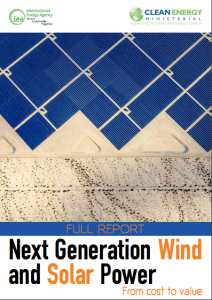Full Title: Next Generation Wind and Solar Power
Author(s): International Energy Agency
Publisher(s):
Publication Date: December 1, 2016
Full Text: Download Resource
Description (excerpt):
Wind and solar photovoltaics (PV) are currently the fastest-growing sources of electricity globally. In 2015, their additional annual generation met almost all incremental demand for electricity. Variable renewable energy (VRE) costs, especially for solar PV and land-based wind, have fallen dramatically in recent years thanks to a combination of sustained technological progress, expansion into newer markets with better resources, and better financing conditions. As a result, between 2008 and 2015, the average cost of land-based wind decreased by 35% and that of solar PV by almost 80%. A “next generation” phase of deployment is emerging, in which wind and solar PV are technologically mature and economically affordable.
The success of these sources is driving change in power systems around the globe. Electricity generation from both technologies is constrained by the varying availability of wind and sunshine, which makes the output of VRE sources fluctuate over time. The degree to which this poses a challenge depends on the interplay of several factors which vary by country.
For this report, detailed case studies were conducted for Brazil, People’s Republic of China (hereafter “China”), Denmark, Indonesia, Mexico and South Africa. These countries are at very different stages of VRE uptake (Figure ES.1) and also highlight the diversity of contexts for VRE integration. Some systems have only one resource available in abundance (solar in Indonesia, wind in Denmark), while others enjoy high quality resources of both wind and solar (such as South Africa and Mexico). In South Africa, power demand matches closely with wind and solar availability, both across the day and across seasons. In Denmark, by contrast, demand does not naturally correspond well with VRE, triggering the need for additional flexible resources to be mobilised for system integration (see below). Brazil can rely on the abundant availability of flexible hydro generation to complement wind and solar power well, while the seasonal generation profile of new run-of-river plants harmonise with the country’s wind resources (wind is more prevalent when less water is available).
